My Child is Autistic…Is Yours?
Let me begin by stressing that I am not at all qualified to make a diagnosis. I am simply sharing with you information provided by Raelyn’s developmental pediatrician, Dr. Leslie Rubin along with our personal experiences. If you google “autism symptoms,” you will find a long list of characteristics. Every single person has at least one of these traits. That doesn’t mean every single person is autistic. That is why it is essential that you have your child evaluated by a PROFESSIONAL if you have concerns. Dr. Rubin explained that there are six categories of features that are evaluated in the diagnosis process. In order to be diagnosed on the autism spectrum, your child must exhibit at least one trait of each category. I will list these six categories and explain how each trait manifested itself in Raelyn. This list was created by Dr. Leslie Rubin.
1. Delay and unusual pattern of speech development:
Most professionals do not acknowledge a true speech delay until your child is 18 months old. However, if you know what to look for, there are noticeable red flags present much earlier than this. Typical kids have at least a couple of true words at 12 months. Raelyn did not have ANY words until about 20 months. A baby typically starts babbling at 3 months. Raelyn didn’t start truly babbling until about 9-12 months. At the time, I didn’t even realize that this was a significant delay. Some kids develop normal language until about 18 months and then hit a plateau or regress. This wasn’t the case with Raelyn, but I know of kids who have gone from saying multiple words to essentially being nonverbal over night.
2. Unusual pattern of communication, interaction, and socialization:
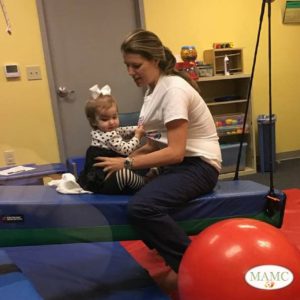
Speech therapy session
Typically developing kids start imitating sounds around age 3-6 months. They start imitating gestures (such as waving) between 6 and 9 months. Raelyn is almost 2 years old and she just started imitating sounds. She still does not imitate gestures. Consistently waving “bye-bye” is a milestone that we are still working on. When I call her name, she only responds maybe 20% of the time. She is able to completely tune out the rest of the world, which is why we were convinced she was deaf. In fact, the majority of kids who are diagnosed with an autism spectrum disorder were first believed to have a hearing impairment. I had no clue this was an early sign of autism, and this is a common reason for delayed diagnosis.
3. Unusual patterns of behavior that tend to be routine, repetitive, and even obsessive or ritualistic:
The classic example of this is “hand flapping.” Hand flapping is extremely common in autism, but it is only one of countless behaviors. These repetitive behaviors are also called “stims,” which stands for “self stimulatory behavior.” These stims can really be anything…a certain sound, body movement, or obsession. Raelyn started stimming as early as 6 months old. When she got excited, she would straighten her arms out in front of her body, make an unusual face, and shake…This later transformed into more of a “hand flapping dance,” which we now refer to as her “happy dance.” Another stim that started around 6 months was sticking her hand down her throat to make herself vomit.

One of her “excited stims”
Again, I had no idea that these behaviors were actually a manifestation of autism. I thought her “happy dance” was just an adorable, quirky thing that she did to get attention or be funny. I figured the reason she gagged herself was related to her severe reflux she has had since she was a newborn. Over the months, Raelyn has picked up new stims and altered old ones. Some only last a few days and others last months and then just stop one day. Some of her current stims are: hand flapping, her happy dance, blowing raspberries, making this strange growling noise, unscrewing lids of containers and screwing them back on, and opening and closing easter eggs.
It seems that most parents of autistic kids describe their kids as “quirky” long before receiving an autism diagnosis. That is exactly what these behaviors are… quirky. These behaviors are coping mechanisms. People with autism can’t communicate or express emotion appropriately or regulate themselves effectively. So they have to develop another way to interact with the world around them. Stimming is their way of doing this.
4. Unusual sensory response:
Most people have some sort of sensory processing issues. If the feeling of holding a piece of chalk makes you cringe or the texture of yogurt makes you want to vomit… this is a sensory related response. It is totally normal. It becomes an issue when it begins to interfere with daily life. From the time Raelyn was just a few months old, she always put EVERYTHING in her mouth. She still does. This is because she craves intense sensory input from the feeling of different textures, tastes, and temperatures in her mouth.
When it was time for her to start learning how to self feed, we noticed that she would only touch certain foods. She wouldn’t touch anything that was slimy, sticky, or wet. So things like pasta and fruit were out of the question. She would eat these foods if I fed them to her, but wouldn’t feed them to herself.
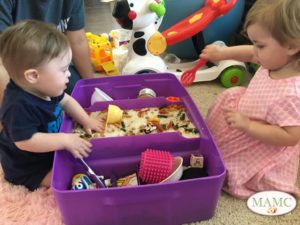
Raelyn and her friend, Asher, playing in her sensory bin
This significantly impacted our lives, so I knew I had to work on this. I started putting her in her highchair with baby food and yogurt and let her put her hands in it. Then I let her finger paint with colored yogurt. I also made her a sensory bin full of dry rice, beans, and pasta. After months of hard work, I am proud to say that today she will touch ANY food!! Raelyn still has strange sensory issues. She is obsessed with spinning in circles, and doesn’t even get dizzy. There are certain textures that she prefers and some that she avoids. She is very sensitive to sounds and certain noises absolutely terrify her (toilet flushing, frying pan sizzling, and certain laughs).
5. Motor organizational difficulties:

Dancing on her tip toes
The most common example is kids walking on their tip toes more often than not. Raelyn has always been a toe walker and she is to this day. Most toddlers toe walk at some point in their development. Unless your kid is toe walking ALL THE TIME and also exhibits traits in the other 5 categories, there’s no reason to stress. Don’t convince yourself that your kid is on the spectrum just because he walks on his toes every now and then.
This category is also the reason that many autistic kids have difficulty saying words on command and imitating gestures. A typical person’s brain doesn’t have to think about something as simple as waving or blowing a kiss. A toddler can watch someone do it once and they will repeat it. However, this doesn’t come naturally to someone with autism. They have to actually think about what they want their hand to do in order to make it wave. This is why a lot of kids meet milestones spontaneously, when they aren’t thinking about it.
6. Dramatic emotional reaction to relatively minor frustrations, disappointments, or failed expectations.
This one is pretty self explanatory. This refers to the notorious “autism meltdowns.” Often times, an autism parents may have no idea what caused the meltdown or how to comfort their child. In my opinion, the best way to deal with this is to really work on sensory integration, which teaches your child how to self regulate when over stimulated. I don’t want to jinx it, but Raelyn doesn’t have many meltdowns.
I think a lot of this is because we started her in therapy at just 17 months old. But she does get frustrated over the smallest things. If she opens an easter egg and can’t get it to fit back together, she throws herself on the floor and starts screaming and thrashing around. It sounds absurd, but in our household, it is just our new normal… not being able to get an easter egg to fit together is meltdown-worthy!!
Even as a newborn, Raelyn was just a very difficult baby,
Every single night for a solid three hours, she would SCREAM unless my husband or I would b ounce her on the yoga ball. She also had terrible reflux until she was about 16 months old. Gastrointestinal issues, such as reflux and constipation are very common in autism. I’m not sure what the correlation is, but most autism parents will tell you that their child with autism has always had stomach issues.
ounce her on the yoga ball. She also had terrible reflux until she was about 16 months old. Gastrointestinal issues, such as reflux and constipation are very common in autism. I’m not sure what the correlation is, but most autism parents will tell you that their child with autism has always had stomach issues.
This list is not a substitute for a professional evaluation. It is simply to help parents pick up on signs at an earlier age. If you read this list and found yourself thinking, “wow that sounds just like my kid,” I highly suggest mentioning it to your pediatrician. It is very common for pediatricians to dismiss parents’ concerns as “all kids develop at their own pace.” Yes, this is true. But if you have a gut feeling about your child, DO NOT STOP FIGHTING FOR THEM. You are your kid’s advocate, and if you don’t make someone listen to your concerns, your child will miss out on getting the therapy he needs.
To read my post about how I missed so many early signs in my daughter, click here.

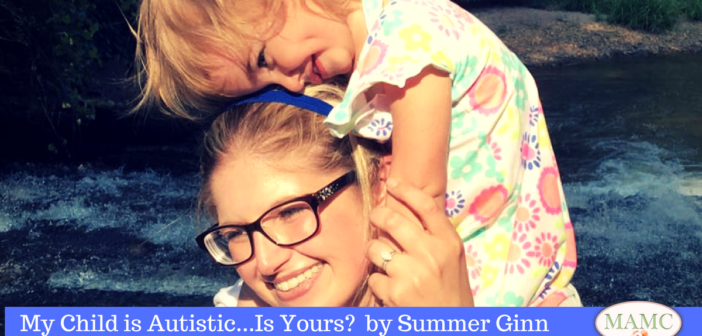
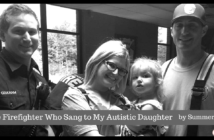
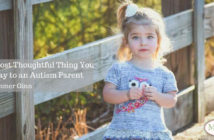
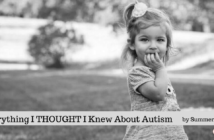
3 Comments
I was suggested this web site by my cousin. I am not sure whether this post is written by him as nobody else know such detailed about my problem. You are incredible! Thanks!|
Oh my goodness! Amazing article dude! Thanks, However I am having issues with your RSS. I don’t know why I can’t subscribe to it. Is there anyone else having similar RSS problems? Anyone that knows the answer can you kindly respond? Thanx!!|
Admiring the time and energy you put into your site and in depth information you provide. It’s good to come across a blog every once in a while that isn’t the same unwanted rehashed information. Great read! I’ve saved your site and I’m including your RSS feeds to my Google account.|